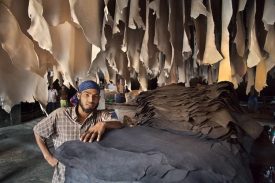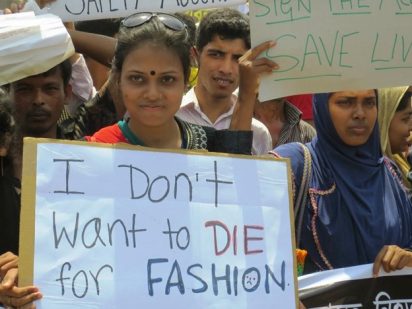Aesthetic Obsolescence: The Quick and Dirty of Fast Fashion

Fast fashion is an easy target for righteous criticism. Environmentally costly but cheap to buy, and systemically unscrupulous yet totally ubiquitous, public opinion has rightly turned against fast fashion in the last several years. Despite a growing awareness of the hidden costs of fast fashion, most people have an imprecise understanding of what “fast fashion” really means and the industry remains highly lucrative. On the whole, customers have been slow to change their shopping patterns. The disruptions to global supply chains caused by the ongoing pandemic may provide a catalyst to accelerate much-needed change in the way we make and buy our clothes.
The disruptions to global supply chains caused by the ongoing pandemic may provide a catalyst to accelerate much-needed change in the way we make and buy our clothes.

What is fast fashion?
Following the influential documentary “The True Cost,” the garment business has come under increasing criticism. “Fast fashion” has since become something of a shorthand for the evils of the entire apparel industry, but like the term “natural foods,” it is often used to refer to several related phenomena. At its most colloquial, fast fashion can refer to once-pervasive chains that sell a massive and ever-changing inventory of trendy, extremely affordable clothing. It is often equated with cheap polyester clothes, but not all fast fashion uses synthetic textiles, nor are all non-fast fashion garments made of natural fibers. Fast fashion is also commonly associated with inhumane and environmentally irresponsible production, although even luxury brands engage in reprehensible business practices and encourage hyperconsumerism.
“Fast fashion” has since become something of a shorthand for the evils of the entire apparel industry, but like the term “natural foods,” it is often used to refer to several related phenomena.”

The formal definition of fast fashion refers not so much to the stores or the merchandise, but to the business model that produces new garments more frequently than traditional seasonal collections, often offering several product launches per month. The approach has been wildly successful, helping drive a 60% global increase in annual garment purchases per person between 2000 and 2014 alone. Globally, fashion now accounts for $1.9 trillion in annual revenue.
Where did fast fashion come from?
In their article “Fast fashion: response to changes in the fashion industry,” Dr. Vertica Bhardwaj and Dr. Ann Fairhursttrace trace the origins of fast fashion style clothing launches to 1989 in the United Kingdom. Consumers, they assert, had become increasingly style conscious in the 1980s and had begun to crave increasingly elaborate, outfit-specific items, rather than being satisfied with the basic styles that major brands had mass-produced in the past. When the market adapted to meet this need in the 1990s, consumers, naturally, embraced some trends while rejecting others. The failed mass-produced trends abruptly created an excess of clothing, pushing prices down. As major brands like H&M ratcheted up the competition to emulate high fashion designs, the pace of product launches increased, further exacerbating the clothing surplus. The price of clothing dropped even lower. Garments, meanwhile, began to be designed for relatively fewer wears before being discarded and replaced. Over the course of the 2000s, the apparel industry reached previously unfathomably low clothing production times. This was achieved through a combination of technological and logistic innovations, like Computer-Integrated Manufacturing and cutting edge Just-in-Time inventory management, and complex networks of supply chains characteristic of economic globalization.
What is the problem?
Producing such high volumes of goods requires extraordinarily rapid production, hence the name “fast fashion.” This approach to textile production has come under scrutiny as consumers have become increasingly aware that its breakneck speed and scale often come at the expense of human and environmental exploitation. The low prices of these clothes are achieved through negative production externalities, the economic term for undesirable, uncompensated side-effects of product manufacture.
There are many oft-cited, but methodologically hazy, figures describing the environmental component of the apparel industry’s environmental cost. The Ellen MacArthur Foundation, a UK based charity, states that the equivalent of a garbage truck full of clothes is discarded as landfill trash or incinerated every second. The World Bank attributes 10% of global carbon emissions to the apparel industry, while other sources put the estimate closer to 3%. Although not directly comparable, this does seem consistent with the EPA’s report that Americans generated about triple the garment-based municipal solid waste in 2008 as we did in 1990 (our population only grew from 248.7 million to 326.8 million in that time). While none of these figures differentiate between fast fashion and other garments, their magnitude indicates a driving economic force with devastating environmental impacts.
Garment workers remain shamefully underpaid, often criminally so. At work, they face a disproportionate share of hazards with the most egregious accidents winding up in international news.
The human costs of cheap apparel are more self-explanatory. Garment workers remain shamefully underpaid, often criminally so. At work, they face a disproportionate share of hazards with the most egregious accidents winding up in international news. In 2012, a factory fire killed 112 people in Bangladesh. Here in the U.S., L.A. Apparel flouted safety protocols in the early days of the pandemic, killing six workers tasked with sewing masks and hospital gowns. Many garment workers endure more mundane abuses, such as poor ventilation, excessively long workdays without breaks and sexual harassment.
Why do people continue to buy it?
The conditions under which mass-produced clothes are made are completely inexcusable, but in practice, the moral incentives to abstain are often rendered moot in the face of necessity. As James Baldwin wrote, “Anyone who has ever struggled with poverty knows how extremely expensive it is to be poor; and if one is a member of a captive population, economically speaking, one’s feet have simply been placed on the treadmill forever.”
Last month Ijeoma Oluo elaborated on Baldwin’s sentiment as it relates to fast fashion. Even as a bestselling author, Oluo recollects holding on to the flimsy furniture and mass-produced clothing she bought as a struggling writer. When her house burned down in 2020, taking all of her possessions with it, she found herself replacing what she had lost with pieces she never would have been able to afford before her writing took off. Oluo recounts how disconnected she had felt from her old belongings, unable to “love any of it because if you are poor you are trapped in a cycle of having to stretch your limited funds to buy the cheap garbage that looks sort of like something you could love but then it falls apart in six months.” At the same time, she describes a paradoxically intimate, very familiar attachment to her lost possessions, “But I did work hard for all of those pieces of sh*t in my home. And I know that my labor isn’t sh*t, and I would have kept all of that sh*t I’d worked so hard for until it fell apart because it had my blood, sweat, and tears in it.”
Oluo’s observation gives clarity to what I have often felt about my own fast fashion purchases. I was never trapped in the cycle of poverty, but I was certainly a low-wage worker until I started waiting tables in my late 20s. Essentially all the clothes I wore between the ages of 18 and 32 were fast fashion. I bought the outfit I am wearing as I write this from Forever 21, maybe five years ago. It is a crop top I have few occasions to wear out anymore and a leopard print skirt that is full of holes with an absurdly uneven hem. Despite my attempts to honor the effort and the carbon that went into making and buying these clothes, as I watch them disintegrate, I have to concede that they were never meant to last.
What has COVID-19 changed about any of this?
According to McKinsey Sustainability, the pandemic has decreased spending on mid-range fashion and shifted purchasing toward both higher end and more affordable alternatives with an increased share of shopping occurring online. The pandemic has also correlated to an increase in second-hand clothing purchases, also increasingly online.
Even more impactful, companies are making changes in the way they operate. COVID’s continuing effects on the global supply chain have caused disturbances in the production and shipment of clothing. Transportation delays and increased shipping costs have incentivized garment construction closer to the intended country of purchase. The lightning fast production of the fast fashion model has historically relied on complex global supply chains. Thus, moving operations may render the speed and scale of pre-pandemic fast fashion infeasible. This would result in a slower rate of garment production with less produced over time. Coupled with companies’ reports of more efficient textile recycling and manufacturing improvements, the industry may finally begin to reduce its environmental impact.

What could the future of apparel look like?
The holy grail of sustainable style is contained in the broader concept of the circular economy. In this ideal, the whole lifecycle of clothing is accounted for, with the entire product being retained or repurposed. This is a long way off. In the meantime, most sustainable style guidance amounts either to buying the most responsibly manufactured product that you will keep the longest, or to buy something used. This advice is, of course, imperfect. It is difficult to discern the most eco-friendly or ethical option, and impossible to completely purge one’s life of problematic purchases.
Thrifting comes with its own set of complications, not the least of which is options for larger bodies being severely limited. It can also be hugely time consuming and most of the time there is no return option, making online shopping a significant financial gamble. Even so, it really feels like things might be getting better. As someone who unrepentantly hates thrifting in person, I can say from experience that you can find beautiful, unique second hand clothes online, with more options every day. If you have a mass-produced item you love, you can often find a good quality copy of that online too. Like a lot of our collective new normal, I cannot honestly call it easy, or ideal. For the first time in my life I can, however, say I think it is becoming feasible.